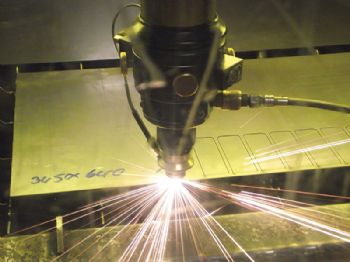
Having one software package covering two different cutting technologies was top of the agenda when an engineering sub-contractor specialising in CNC punching bought a company that focused on laser cutting.
Sawtry-based Harley Engineering (
www.liberate-eng.co.uk/harley) wanted to complement the services it offered and widen its customer base, and reckoned it needed to either buy a laser cutter or acquire a company with laser machines. Eventually, it bought Liberate Engineering, which is a 40min drive away across the Cambridgeshire Fens.
One of the first things Harley did on acquiring Liberate was to replace the existing sheet-metal CAD/CAM system driving the latter’s 3kW, 3m-bed Trumpf and Laserlab lasers with Radan from Vero Software (
www.radan.com).
William Eveleigh — managing director of Liberate and general manager of Harley — says there was so much synergy between the two businesses that it made sense to bring them together under a new holding company, HAL.
“However, we needed the same software package to bring total connectivity between the two companies. We had used Radan’s Radpunch module at Harley to program our Amada Vipros King punch press for around 10 years, so we brought in Radprofile for the lasers.”
This arrangement also means that programming for both types of technology can be done at either site and the finished nest sent to the appropriate machine tool.
“Speed is critical to our operation, and if there’s an issue with a machine or jobs are queuing up at one factory, we can quickly switch from the punch at Harley to a laser at Liberate, and vice versa.”
At the time of the acquisition, Harley focused mainly on ATM equipment and point-of-sale products for the financial sector, along with the construction industry, while Liberate had considerable experience in the agricultural market, including manufacturing components used in vegetable-processing plants, and seed-drilling equipment. It also had a thriving market producing components for large commercial printing machines.
“Harley’s customers were increasingly wanting laser-cut parts, which we had to sub-contract out. Now we can offer existing customers an in-house service and save on sub-contracting costs. We also found that a number of Liberate’s customers were looking for some of their parts to be punched.”
The type of products range from straight cut blanks with no further processing to finished, painted and plated parts. “For example, in vegetable-processing plants where the goods are harvested and brought into the factory for cleaning and packaging, we’d typically manufacture all the side panels and brackets for the large conveying machines. We also make component parts, such as brackets for holding electronic machinery inside commercial printers that can print advertising billboard pictures in just one or two passes.”
Liberate’s laser cell leader, Terry Boyden, says Radan is so powerful and versatile that there was a lot to learn when it was installed after the acquisition around three years ago. “It’s such a vital tool that I couldn’t do without it now. All I need do is select laser profiling to create the parts, and I particularly like how they’re changed automatically on the nest if you amend them. If I need to add another hole or change a notch, I just call the part up and edit it, without having to re-nest. That’s a massive time-saver for me.”
Another feature which he says is invaluable is the ability to photograph a blank piece of metal and upload it as a bitmap to Radan. “It’s so simple to convert it to a cutting file, which saves time and reduces the risk of getting it wrong. It is also proving effective where customers want their logo on a job, either etched or cut as a profile. In the past, we had to draw that, but now we just photograph it.”
He also acknowledges the benefits offered by Radan 3D, as does Harley’s workshop foreman Jeff Burrill, who says: “After importing a STEP file into Radan 3D, I flatten it and then develop it, taking out any unnecessary corners, and put the tooling on. For me, Radan’s most important feature is going from 3-D to flat blanks, as it means I can go straight on to the shopfloor with something ready for manufacturing.
“It only takes up to 10min to ‘flatten out’ most components and get them ready for cutting. I use the software on a daily basis, because a lot of parts have too many folds to be able to work on them efficiently in 2-D.”
A total of 21 employees are based across the two sites, which both run press brakes. Mr Eveleigh says he is considering investing in Radbend, as it is becoming increasingly difficult to find the skilled labour required
to carry out the setting and bending. “It will de-skill the job of running Liberate’s Amada 4m 200-tonne and 2.5m 80-tonne press brakes — as well as Harley’s older Edwards Pearson press brake — and give us greater bending technology in both offices.
“Our biggest challenges are material utilisation and speed, which Radan successfully solves. It gives us a considerable saving on wastage with accurate nesting and usable offcuts; and we can quickly and accurately create and manipulate parts on screen, getting them ready for either the punch or lasers.”